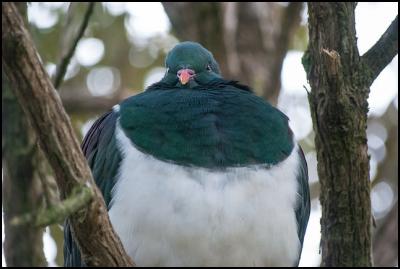Flap, Flap and Away – Great Kererū Count closes Sunday
Flap, Flap and Away – Great Kererū Count closes Sunday

Photo: Tony Stoddard
Kiwis, make your final kererū counts this weekend!
The Great Kererū Count team needs New Zealanders across the county to keep their eyes on the skies to help build up a comprehensive picture of where our native pigeon is – and isn't – found. The annual count closes this Sunday, 25th of September, at midnight.
Kererū are known as the "gardeners of the skies" and play a crucial role for forest regeneration. Great Kererū Count data is critical not just for protecting this species, but for ensuring the vitality of our forest ecosystems for future generations.
The information collected from this nation-wide “citizen science” project will be used by conservationists to better protect kererū and to help save our native forests.
Tony Stoddard, WWF-New Zealand’s Great Kererū Count Coordinator, is encouraging everyone to take part by counting the kererū in backyards, schools, parks or reserves.
“With school holidays starting Friday, this is a perfect time for families and friends to get outside and get involved with this fun conservation count,” Mr Stoddard said.
“Kererū are distinctive looking birds," Mr Stoddard explains. "With their large size and bright white singlets, surrounded by green and purple plumage, they are easy to spot perched in treetops or on power lines.
“Whether you see any kererū or not, sharing your observations with us will help build up a clearer picture of where the birds live, how many there are and what they eat.”
This year we have three options for you to make your kererū observations – via www.greatkererucount.nz,www.naturewatch.org.nz or with the iNaturalist App available on iTunes and Google Play.
“To make kererū
counts, people can use a computer, laptop, tablet or
smartphone – whatever works best for the observer,” Mr
Stoddard said.
The kererū is the only mainland bird that can swallow large berries from trees like tawa, puriri, miro and karaka.
“The kererū is a key-stone species for native forest ecosystems as they distribute seeds, playing a key role in regenerating broadleaf forests,” he said.
“We really need Kiwis this year to help us build up a detailed picture of how kererū are distributed across the country, what they are feeding on, and especially the extent to which they are found in towns and cities.”
The Great Kererū Count is a partnership between WWF-New Zealand, Kererū Discovery, Victoria University of Wellington, WCC, and NatureWatch NZ.
ENDS
·
Kererū are also known as kūkū / kūkupa/ kokopa / New
Zealand pigeon (Hemiphaga novaeseelandiae).
· Threats to kererū include habitat loss through forest clearance, predation by rats, stoats, possums and cats, and competition for food (leaves, flowers, and fruit) with possums.
· The count has been going since 2011.
· In 2015:
- There were 8,743 reported sightings and 19,640 kererū counted.
- The greatest number of birds recorded per 1000 people was made in the West Coast region, followed by Tasman and Wellington.
- Understanding the spatial patterns and distribution of kererū in New Zealand is critical to the conservation of the species. It is evident that observations of kererū are clustered around urban centres – with high concentrations of observations in the Wellington, Auckland, Nelson and Otago regions.
· Great Kererū Count observations can also be made via the iNaturalist app for android and iPhones. It is available to download free from www.greatkererucount.nz
About WWF
WWF is one of the world's largest and most respected independent conservation organisations, with over 5 million supporters and a global network active in over 100 countries. WWF's mission is to stop the degradation of the earth's natural environment and to build a future in which humans live in harmony with nature, by conserving the world's biological diversity, ensuring that the use of renewable natural resources is sustainable, and promoting the reduction of pollution and wasteful consumption.


 Gordon Campbell: Papal Picks, And India As A Defence Ally
Gordon Campbell: Papal Picks, And India As A Defence Ally Te Pāti Māori: Te Pāti Māori Make Submission To Privileges Committee In Absentia
Te Pāti Māori: Te Pāti Māori Make Submission To Privileges Committee In Absentia PSA: PSA Forces Changes To Restructure Of Data & Digital And Pacific Health
PSA: PSA Forces Changes To Restructure Of Data & Digital And Pacific Health Waitangi Treaty Grounds: Anzac Day Commemorative Evening Service At The Waitangi Treaty Grounds
Waitangi Treaty Grounds: Anzac Day Commemorative Evening Service At The Waitangi Treaty Grounds Ministry For Culture And Heritage: New Zealand Flag Half-Masting To Mark The Passing And Funeral Of His Holiness Pope Francis
Ministry For Culture And Heritage: New Zealand Flag Half-Masting To Mark The Passing And Funeral Of His Holiness Pope Francis NZ Government: PM Sends Condolences On Passing Of Pope Francis
NZ Government: PM Sends Condolences On Passing Of Pope Francis NZDF: Battlefield Remains Unearthed By Wildfires In Gallipoli Covered Over By Kiwi Team
NZDF: Battlefield Remains Unearthed By Wildfires In Gallipoli Covered Over By Kiwi Team


